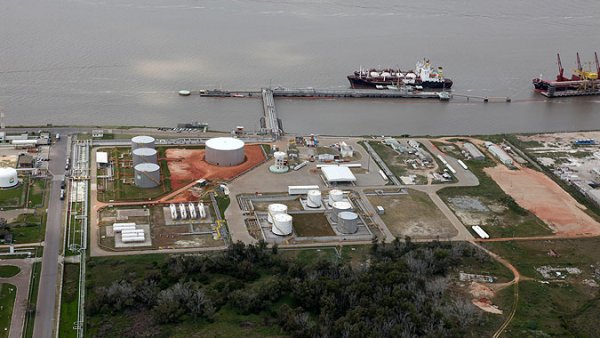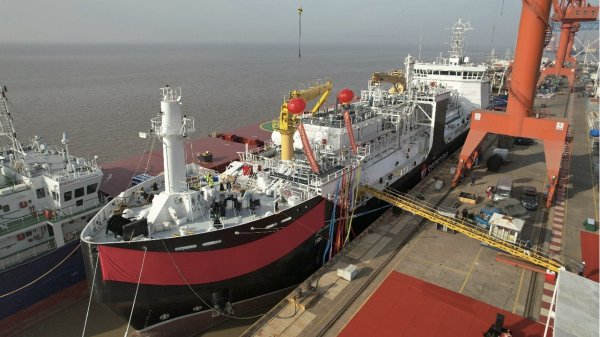Steam-powered vessel arrives at shipyard for repowering
S.S. Herbert C. Jackson is to undergo a six-month conversion to a diesel propulsion system.
The S.S. Herbert C. Jackson [pictured] made its final journey as a steamship this month when it sailed into Fraser Shipyards in Superior, Wisconsin, where it is to undergo a six-month conversion to a highly automated diesel propulsion system.
As the last steam-powered ship in Interlake Steamship Company's fleet, the Jackson is the fifth ship to undergo a major overhaul and its fourth steam-to-diesel conversion since 2006. This conversion represents the final phase of the company's 10-year, $100 million modernization effort to create the most efficient, reliable and environmentally friendly fleet on the Great Lakes.
Regularly carrying almost 25,000 tonnes of iron ore between Marquette and Detroit, Michigan, the 690-foot Jackson was powered by an ageing steam turbine and two boilers, which have operated since the ship was built in 1959. Maintenance burdens and new emission requirements fuelled Interlake's decision to repower the ship.
"We have a long-term vision for this industry and made the decision 10 years ago to invest in new technology that will allow us to reduce our carbon footprint and environmental impact while increasing our reliability for our customers," commented Interlake President Mark W. Barker.
Following a significant capital investment at its Wisconsin shipyard, Fraser was selected by Interlake to carry out the re-engineering - a large-scale, multifaceted project.
"From a shipping company's perspective, it's important to have multiple facilities, such as Fraser Shipyards, that can handle complex projects like this," Barker said. "Fraser has invested considerably in its infrastructure and its people to do a project of this size. Given the increased activity at all yards across the Great Lakes, we felt Fraser has proven its ability to do this repower."
"The entire Fraser Team is looking forward to successfully completing the repowering project," said James Farkas, president and COO of Fraser Shipyards. "We are honoured to have been selected for this project. Our team is very excited and so is our surrounding community to have the Herbert C. Jackson here in our shipyard and to be a part of such a transformation."
It is the first major repowering for Fraser Shipyards since the mid-1980s.
"This is a huge step forward for our shipyard and what we hope is the first of many large projects. We have added almost 2,000 feet of new dockage and completely upgraded the electrical in the yard. In addition to our normal winter work during lay-up, we'll have between 65 and 75 people dedicated full time to this repowering project," said Tom Curelli, vice president of Fraser's engineering, environmental services.
The Jackson's new 6,250-BHP propulsion package includes a pair of MaK 6M 32E engines - the first of their kind to power a vessel on the Great Lakes - which is designed to give the ship enhanced propulsion capabilities and reliability. In addition, the ship will receive a twin-input, single-output Lufkin gear box with twin pto shaft generators, a Schottel controllable-pitch propeller system and Gesab exhaust gas economizers along with an auxiliary boiler. The economizers allow the ship to harness the waste heat and energy from the main engine exhaust and produce 'free steam' to heat the accommodations and for heating various auxiliary systems and fuel oil services.
In total, the repowering is estimated to reduce the ship's emissions of particulate matter by 35 percent, carbon dioxide (CO2) by 57 percent and sulphur oxides (SOx) by 63 percent.
"Not only are these engines extremely efficient, they are dual-fuel capable, thus could be modified to be fuelled by LNG if the supply chain infrastructure for supplying LNG is built out around the Great Lakes," Barker said. "By choosing these engines, we have the enhanced capability to further lower our environmental footprint in the future."
After a round of sea trials, the Jackson is expected to resume its Great Lakes trade routes by late-June 2016.
As the last steam-powered ship in Interlake Steamship Company's fleet, the Jackson is the fifth ship to undergo a major overhaul and its fourth steam-to-diesel conversion since 2006. This conversion represents the final phase of the company's 10-year, $100 million modernization effort to create the most efficient, reliable and environmentally friendly fleet on the Great Lakes.
Regularly carrying almost 25,000 tonnes of iron ore between Marquette and Detroit, Michigan, the 690-foot Jackson was powered by an ageing steam turbine and two boilers, which have operated since the ship was built in 1959. Maintenance burdens and new emission requirements fuelled Interlake's decision to repower the ship.
"We have a long-term vision for this industry and made the decision 10 years ago to invest in new technology that will allow us to reduce our carbon footprint and environmental impact while increasing our reliability for our customers," commented Interlake President Mark W. Barker.
Following a significant capital investment at its Wisconsin shipyard, Fraser was selected by Interlake to carry out the re-engineering - a large-scale, multifaceted project.
"From a shipping company's perspective, it's important to have multiple facilities, such as Fraser Shipyards, that can handle complex projects like this," Barker said. "Fraser has invested considerably in its infrastructure and its people to do a project of this size. Given the increased activity at all yards across the Great Lakes, we felt Fraser has proven its ability to do this repower."
"The entire Fraser Team is looking forward to successfully completing the repowering project," said James Farkas, president and COO of Fraser Shipyards. "We are honoured to have been selected for this project. Our team is very excited and so is our surrounding community to have the Herbert C. Jackson here in our shipyard and to be a part of such a transformation."
It is the first major repowering for Fraser Shipyards since the mid-1980s.
"This is a huge step forward for our shipyard and what we hope is the first of many large projects. We have added almost 2,000 feet of new dockage and completely upgraded the electrical in the yard. In addition to our normal winter work during lay-up, we'll have between 65 and 75 people dedicated full time to this repowering project," said Tom Curelli, vice president of Fraser's engineering, environmental services.
The Jackson's new 6,250-BHP propulsion package includes a pair of MaK 6M 32E engines - the first of their kind to power a vessel on the Great Lakes - which is designed to give the ship enhanced propulsion capabilities and reliability. In addition, the ship will receive a twin-input, single-output Lufkin gear box with twin pto shaft generators, a Schottel controllable-pitch propeller system and Gesab exhaust gas economizers along with an auxiliary boiler. The economizers allow the ship to harness the waste heat and energy from the main engine exhaust and produce 'free steam' to heat the accommodations and for heating various auxiliary systems and fuel oil services.
In total, the repowering is estimated to reduce the ship's emissions of particulate matter by 35 percent, carbon dioxide (CO2) by 57 percent and sulphur oxides (SOx) by 63 percent.
"Not only are these engines extremely efficient, they are dual-fuel capable, thus could be modified to be fuelled by LNG if the supply chain infrastructure for supplying LNG is built out around the Great Lakes," Barker said. "By choosing these engines, we have the enhanced capability to further lower our environmental footprint in the future."
After a round of sea trials, the Jackson is expected to resume its Great Lakes trade routes by late-June 2016.

|
IMO approves pricing mechanism based on GHG intensity thresholds
Charges to be levied on ships that do not meet yearly GHG fuel intensity reduction targets. |
|
|
|
||

|
VARO Energy expands renewable portfolio with Preem acquisition
All-cash transaction expected to complete in the latter half of 2025. |
|
|
|
||

|
NYK trials biofuel in milestone coal carrier test
Vessel is used to test biofuel for domestic utility company. |
|
|
|
||

|
H-Line Shipping orders LNG bunkering vessel
Vessel with 18,000-cbm capacity to run on both LNG and MDO. |
|
|
|
||

|
How to engineer and manage green shipping fuels | Stanley George, VPS
Effective management strategies and insights for evolving fuel use. |
|
|
|
||

|
Swedish government bans scrubber wastewater discharges
Discharges from open-loop scrubbers to be prohibited in Swedish waters from July 2025. |
|
|
|
||

|
MAN Energy Solutions achieves 100% load milestone for ammonia engine
Latest tests validate fuel injection system throughout the entire load curve. |
|
|
|
||

|
Petrobras secures ISCC EU RED certification for B24 biofuel blend at Rio Grande
Blend consisting of 24% FAME is said to have been rigorously tested to meet international standards. |
|
|
|
||

|
Stolt-Nielsen to fully control Avenir LNG with acquisition
Share purchase agreement to buy all shares from Golar LNG and Aequitas. |
|
|
|
||

|
Bureau Veritas supports launch of CIMC SOE's LNG bunkering vessel
Handover of Seaspan Energy's cutting-edge 7,600-cbm vessel completed. |
|
|
|
||
Related Links
- · Interlake Steamship to install more scrubbers [Insights]
- · United States [Directory]

